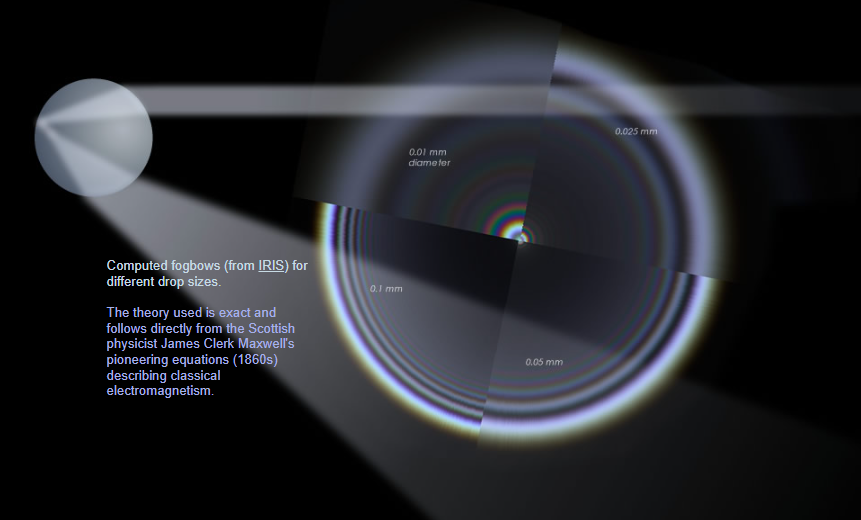Pacific Coast Trail Fogbow - OPOD
Pacific Coast Trail Fogbow - OPOD: A Spectacular Atmospheric Phenomenon
Fogbows, also known as diffraction-challenged rainbows, are captivating atmospheric optics phenomena that occur when sunlight interacts with tiny water droplets in foggy conditions. While rainbows are formed by the refraction and reflection of light through raindrops, fogbows are created by the diffraction of light through fog droplets. Recently, an awe-inspiring fogbow was captured by Bernhard Bach of the University of Nevada, Reno while walking the Pacific Coast Trail in the Marin Headlands, just across the Golden Gate Bridge from San Francisco.
Unlike rainbows, which exhibit a wide range of vibrant colors, fogbows tend to be pale and lack the distinct color bands. As the droplets that form fogbows become smaller, they broaden and lose more color. This phenomenon can be observed in the fogbow imaged by Bach, where the small droplets contribute to the broadening and fading of colors.
The formation of fogbows can be explained by the theory of classical electromagnetism, as described by Scottish physicist James Clerk Maxwell in the 1860s. Maxwell's pioneering equations provide an exact understanding of the diffraction of light through small droplets, elucidating the intricacies of fogbow formation.
To further explore the science behind fogbows, computational models have been developed to simulate their appearance for different drop sizes. These models, such as those generated by IRIS (Integrated Research Infrastructure for the Atmosphere), offer valuable insights into the optical properties of fogbows and enhance our understanding of their formation.
The Pacific Coast Trail fogbow captured by Bernhard Bach is a testament to the beauty and allure of atmospheric optics. Its ethereal appearance against the backdrop of the Marin Headlands showcases nature's ability to create captivating displays even in seemingly ordinary conditions.
Here are some key points to note about fogbows:
- Fogbows are formed by the diffraction of light through tiny water droplets in foggy conditions.
- Unlike rainbows, fogbows lack vibrant colors and appear pale due to the diffraction challenges faced by smaller droplets.
- The fogbow captured on the Pacific Coast Trail exhibited broadening and fading of colors due to the presence of small droplets.
- James Clerk Maxwell's pioneering equations in classical electromagnetism provide a theoretical basis for understanding the formation of fogbows.
- Computational models, such as those generated by IRIS, allow for the simulation of fogbows for different drop sizes, aiding in the study of their optical properties.
- Fogbows serve as a reminder of the intricate and captivating phenomena that can occur in our atmosphere, even in seemingly ordinary conditions.
The Pacific Coast Trail fogbow imaged by Bernhard Bach not only adds to the collection of stunning atmospheric optics photographs but also serves as a reminder of the beauty and complexity that surrounds us. As we continue to explore and understand these natural wonders, we gain a deeper appreciation for the remarkable phenomena that occur in our atmosphere. Whether it's a fogbow, a rainbow, or any other captivating display, let us marvel at the wonders of nature that never cease to amaze us.

Marin County Fogbow
Imaged by Bernhard Bach of the University of Nevada, Reno while walking the Pacific Coast Trail, in the Marin Headlands, just across the Golden Gate bridge from San Francisco.
©Bernhard Bach, shown with permission
Scroll right for full panorama.

This fogbow came from small droplets with some diversity of size.
Fogbows - diffraction challenged rainbows - broaden and lose more and more colour as the droplets forming them get smaller.

Computed fogbows (from IRIS) for different drop sizes.
The theory used is exact and follows directly from the Scottish physicist James Clerk Maxwell's pioneering equations (1860s) describing classical electromagnetism.
Note: this article has been automatically converted from the old site and may not appear as intended. You can find the original article here.
Reference Atmospheric Optics
If you use any of the definitions, information, or data presented on Atmospheric Optics, please copy the link or reference below to properly credit us as the reference source. Thank you!
-
<a href="https://atoptics.co.uk/blog/pacific-coast-trail-fogbow-opod/">Pacific Coast Trail Fogbow - OPOD</a>
-
"Pacific Coast Trail Fogbow - OPOD". Atmospheric Optics. Accessed on November 26, 2024. https://atoptics.co.uk/blog/pacific-coast-trail-fogbow-opod/.
-
"Pacific Coast Trail Fogbow - OPOD". Atmospheric Optics, https://atoptics.co.uk/blog/pacific-coast-trail-fogbow-opod/. Accessed 26 November, 2024
-
Pacific Coast Trail Fogbow - OPOD. Atmospheric Optics. Retrieved from https://atoptics.co.uk/blog/pacific-coast-trail-fogbow-opod/.